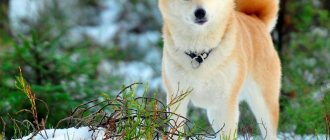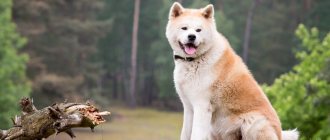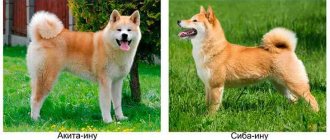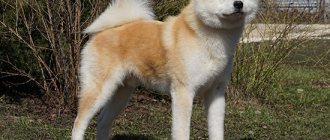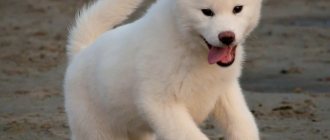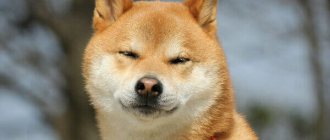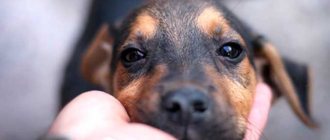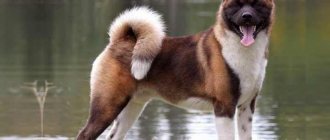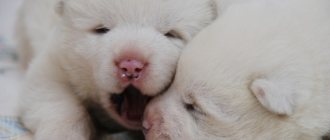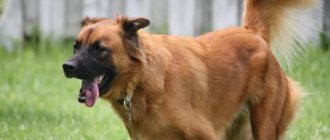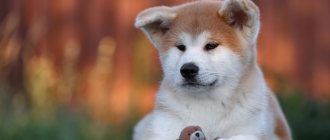Theses
- They are aggressive towards other dogs, especially those of the same sex.
- These dogs are not for novice dog owners.
- Socialization and persistent, competent training are extremely important for these dogs. If they have not been treated or raised correctly, they often become aggressive.
- They shed a lot!
- They get along well in an apartment, but need walks and physical activity.
- They are excellent guards, attentive and reserved, but they need a firm hand.
History of the breed
Japanese sources, both written and oral, describe the ancestor of the breed, the Matagi Inu dog (Japanese: マタギ犬 - hunting dog), one of the oldest dogs on the planet. Matagi, an ethnosocial group of Japanese living on the islands of Hokkaido and Honshu, are born hunters.
And it is the island of Honshu (Akita Prefecture) that is considered the birthplace of the breed, the place that gave the name to the breed. The breed's ancestors, the Matagi Inu, were used exclusively as hunting dogs, helping to hunt bears, wild boars, serows and Japanese macaques.
This breed has been influenced by other breeds from Asia and Europe, including: English Mastiff, Great Dane, Tosa Inu. This happened at the beginning of the 20th century, due to the growing popularity of dog fighting in the city of Odate and the desire to get a more aggressive dog.
According to some sources, they were crossed with German Shepherds during World War II to avoid government regulations requiring that all dogs not suitable for war be destroyed.
To understand the history of the breed, you need to understand the history of the country. For hundreds of years it was an isolated country ruled by shoguns. A professional army made up of samurai helped maintain power in Japan.
These people were brought up with contempt for pain, both their own and that of others. It is not surprising that dog fights were very common, especially in the 12th and 13th centuries. This harsh selection has left very few dogs that are kept as pets and for entertainment.
But, in the 19th century, the industrial era begins. The country needs metals, gold and silver. A lot of city dwellers are moving to rural areas, which increases the number of thefts and crimes. The peasants are forced to retrain the Matagi Inu (purely a hunting dog) as a watchman and guard.
At the same time, new breeds of dogs are coming from Europe and Asia, and dog fighting is again gaining popularity in the country. Opponents include both Tosa Inu (another Japanese breed), and mastiffs, Great Danes, and Bullmastiffs. Owners cross them with indigenous breeds to create larger, meaner dogs. However, this worries many Japanese as the native dogs begin to dissolve and lose their features.
In 1931, the breed was officially declared a natural monument. The mayor of Odate City (Akita Prefecture) creates the Akita Inu Hozankai Club, the purpose of which is to preserve the originality of the breed through careful selection. Several breeders breed these dogs, avoiding those individuals whose features show hybridization.
The breed is called Odate, but later renamed Akita Inu. In 1934, the first breed standard appeared, which would later be amended. In 1967, the Akita Dog Preservation Society created a museum that stores documents and photos about the history of this breed.
The real blow for the breed was the Second World War, during which the dogs practically disappeared. At the beginning of the war, many of them suffered from malnutrition, then they themselves were eaten by the starving population, and their skins were used as clothing.
In the end, the government issued a decree according to which all dogs not participating in hostilities must be exterminated, as a rabies epidemic began in the country. The only way to save the dogs was either to shelter them in remote mountain villages (where they again crossed with the Matagi Inu) or cross them with German shepherds.
It is only thanks to Morie Sawataishi that we know this breed today, it was he who began to restore the breed after the occupation. Hobbyists restored the stock, looked for only purebred dogs and avoided crossbreeding with other breeds.
Gradually their number increased, and the American military and sailors brought these dogs home. By 1950, there were about 1,000 registered dogs, and by 1960 this number had doubled.
American Akita
The paths of the Akita Inu and the American Akita began to diverge after World War II. At this time, Japan, as a losing country in the war, was under US occupation, and there were many American military bases on its territory. The military were fascinated by the large Japanese dogs and tried to bring the puppies to America.
However, the Japanese did not feel any desire to share high-quality, purebred dogs, which they themselves collected bit by bit throughout the country. And the Americans themselves preferred large, bear-like dogs, mixed breeds with other breeds, small and graceful.
American fanciers of the breed bred a larger, heavier and more menacing dog, calling it the Great Japanese. Although both types come from the same ancestors, there are differences between American and Japanese dogs.
While any color is acceptable for American Akitas, Akita Inus can only be red, red-fawn, white, spotted. Also, American ones may have a black mask on their face, which for Japanese ones is a reason for disqualification. The American ones are heavier boned and large with a bear-like head, while the Japanese are smaller, lighter and have a fox-like head.
To gain recognition from the AKC, US breeders agreed to stop importing dogs from Japan. Only those that were in the USA could be used for breeding. This made the gene pool very limited and minimized the possibility of breed development.
The Japanese, on the other hand, were unlimited and could develop the breed as they saw fit. They focused on producing dogs of specific colors and sizes.
As a result, the American Akita and the Akita Inu, although they have common ancestors, differ from each other in many ways.
History of the American Akita
A strong and beautiful dog, has an athletic build and belongs to the Spitz family, got its name from the Japanese city of Akita, a province on the island of Honshu.
In its homeland, the Akita Inu is used mainly as a watchdog and police dog, although throughout the world it is a beloved family member. The Japanese are fighting for the purity of the breed, and over the past three centuries the Akita Inu species has not changed significantly. In the past, these dogs were known to be good hunters of boars, deer and even bears. The affection and devotion of Akita Inu dogs to humans has gone down in history. Recently, Akita Inu dogs have become especially popular in Moscow and Krasnoyarsk. They are valued all over the world for their strength, courage, easy-going nature and obedience.
At the international assembly of countries participating in the FCI, in 1999, it was decided to distinguish two groups of Akita dogs: group 5 FCI - Akita Inu dogs, group 2 - BJA dogs.
According to the FCI classification, breeding passports with descriptions have been created for each dog breed. Explanation of the NIPO standard is intended to protect the purity of the Akita Inu dog breed, it refers to the standard of the Japanese Dog Preservation Society. The standard provides a detailed description of all the characteristics and external signs of the Akita Inu.
American Akitas have quite a long history. In Japan in the 17th century, there were Akita Matagi dogs, which were used both for hunting large animals and for brutal dog fights. Akitas were mainly bred in the palaces of the nobility, and many rituals were developed for feeding and caring for dogs. Each dog had a “servant” who wore a special uniform with special decorations. In the mid-19th century, these dogs began to be crossed with mastiffs and Tosa Inu, and according to some reports, also with Great Danes, bulldogs and St. Bernards, thanks to which the dogs became more large, athletic and brave.
The American Akita, or Great Japanese Dog, is first and foremost an excellent companion and family dog. Akita can also be a very good hunter, guard (guard qualities are well developed), or fighter (with proper upbringing).
Many people confuse the American Akita with the Akita Inu, but this is not true!
The American Akita (Large Japanese Dog) and Akita Inu are officially different breeds. The American Akita differs from the Akita Inu in its larger and more massive build, more varied colors and soft coat! However, the American Akita and Akita Inu have much in common in character. American Akitas also have excellent self-control, although they do not hide their emotions as carefully as their parent breed. American Akitas also bark very, very rarely, and only for a reason!
The American Akita is a very sociable dog, an excellent nanny, patient with children, and loves to play with them. He gets along well with other pets, especially if he has been raised with them since childhood. Akitas are prone to dominance, so when new pets appear in the house, you need to keep an eye on the dog; sometimes it can establish the limits of its dominance using somewhat aggressive methods. Sometimes the Great Japanese Dog can realize its hunting instincts on smaller pets, which is corrected by education.
The American Akita gets along well both in a country house and in a small city apartment. This dog does not need significant physical activity, so standard walks twice a day are sufficient for it. The Large Japanese Dog is very people-oriented, so it is not a good fit for you if you are not home much.
The strongest character trait and meaning of life for all Akitas is to protect their owner and be close to him! The dog, incredibly devoted to its family, is quite cold towards strangers until it decides for itself whether this person can be trusted.
The word "American" in the breed's name can be confusing when it comes to its origins. The second name - large Japanese dog - is more eloquent in this regard: its homeland is the Land of the Rising Sun. But how did it happen that the Akita suddenly became American?
The ancestors of the American Akita are the Japanese Akita Inu, which were originally used for hunting and guard purposes. Several centuries ago they were called differently: Matagi-Akita. Later they began to be used in dog fighting, which became especially popular at the turn of the 19th and 20th centuries. In pursuit of monetary gain, owners sought to “improve” their dogs, making them larger and stronger. For this purpose, they were crossed with breeds brought to the islands such as mastiffs and shepherd dogs.
However, as a result of these manipulations, the classic features of the breed began to blur, deteriorate, or even be completely lost. The damage caused to the Matagi Akita was noticed at a dog show held in Tokyo in 1914. Soon, pure representatives of the breed were declared natural monuments, and their crossing with representatives of other species was strictly prohibited. The breeders had more work to do: they did everything possible to return the Matagi Akita to its original characteristics.
Before these magnificent dogs, which became the source of national pride for the Japanese, had time to recover from the blow inflicted on the breed by irrepressible human greed, World War II broke out. By order of the government, all breeders donated their pets to the needs of the front. As is known, the end of the war was marked by the surrender of Japan in 1945.
At the same time, overseas the breed began to gain widespread recognition and developed at a rapid pace. At first it was called a large Japanese dog. But in the States, work on the breed was not synchronized with the Japanese - it proceeded in parallel and, as they say, on its own path. Japanese breeders tried to negotiate with their American colleagues regarding her common pedigree, but in vain.
In 1956, a club for the newly formed breed was created, recognized by the American Kennel Club only in 1972. The “breed war” with Japan continued until 1992: for two decades, the kennel clubs of both countries did not recognize each other - only the Japanese Akita Inu was registered with the Fédération Cynologique Internationale (FCI). The official division of the breeds occurred only in 2000, when the FCI approved the standard for the overseas Akita.
The American Akita is a very large dog. Strength and power can be read in her every movement. Gradually, the hunting skills of these dogs are becoming a thing of the past, which is largely due to their large size, which prevents the overseas “Japanese” from remaining fast and agile hunters.
Thanks to its special appearance features, namely its spectacular color and perfect lines, the American Akita has long been “registered” at dog shows in different countries of the world, including Russia. Representatives of the breed often lead in BESTS of the fifth group, often winning entire competitions.
general description
It is very difficult to confuse an American Akita with another breed - it is almost impossible, even if before “personal acquaintance” you had only seen it in a photo. The first thing that will catch your eye, in addition to its impressive size, is its strong body with well-developed muscles and massive bones. The “bear” type muzzle with small eyes and a relatively short bridge of the nose will definitely attract attention.
The height and weight of the American Akita, as well as the proportions of the body, vary depending on gender. The height of males at the withers varies from 66 to 71 cm, females - from 61 to 66 cm. The weight of adults is usually: males 45-65 kg, females 32-45 kg.
For males, the ratio of the height at the withers to the length of the body is 9:10, for females it is 9:11. The distance from the foot to the tip of the nose correlates with the distance from the foot to the occipital protuberance in a ratio of 2:3.
Head
The head is the hallmark of the breed. Massive, but at the same time in harmony with the body. There are no skin folds (wrinkles) - provided that your pet is in a calm state. When viewed from above, the shape of the head resembles an obtuse triangle.
The skull is wide and flat, with a shallow groove running upward along the forehead. The transition from forehead to nose (stop) is well expressed, but not sharp.
Wide and voluminous muzzle with powerful, square-shaped jaws. The suspension of the jaws is light. The ratio of muzzle length to skull length is 2:3.
The bite is characterized as a regular scissor bite. However, the breed standard also allows for a straight bite. The teeth are strong, the dental formula must be completely present.
The Akita's eyes are small, almost triangular in shape, and deep-set relative to the size of the head. Color – dark brown. The eyelids are black and fit tightly.
We suggest you read: How to choose an aquarium or which aquarium is better
The ears are also small in relation to the rest of the head. Standing, triangular in shape. They have a wide base on strong cartilage, slightly rounded at the ends. The setting is not too low. Above the eyes, at the level of the scruff of the neck, slightly tilted forward.
When pulling the ear forward, its tip should ideally touch the edge of the upper eyelid. If you look at the Akita's ears from the side, they seem to continue the top line of the neck.
Nose and lips
The nose is black, wide, the nostrils are well open. Liver color is allowed, but only the American Akita is white. Although it is still preferable to “classic” the breed, that is, the black color of the nose.
The lips are also black, dry, and fit tightly. The tongue is pink.
Massive, thick and relatively short, with minimal dewlap. Muscular, widening towards the shoulders. The scruff has a good convexity, smoothly passes into the base of the skull and merges with it.
Frame
Description
Like other Spitz breeds, it is adapted to life in cold climates. Characteristic features of the breed are: a large head, erect, triangular ears, a curled tail and a powerful build. Adult males reach 66-71 cm at the withers and weigh 45-59 kg, and females 61-66 cm and 32-45 kg. Dogs of Japanese origin are usually smaller and lighter.
The size and weight of puppies will vary depending on the individual, but in general you can expect:
- for American Akita puppies aged 8 weeks: from 8.16 to 9.97 kg
- for Akita Inu puppies aged 8 weeks: from 7.25 to 9.07
These dogs grow slowly and reach full development by the third year of life. The growth rate of puppies may vary, some gradually increase in size week after week, others grow quickly, then slow down.
In general, a gain of 5.5 to 7 kg each month can be considered normal until the dog gains 35-40 kg. From this point on, growth slows down, but does not stop until the dog reaches its full potential.
There are growth charts, but don't worry if your puppy doesn't meet them, they are very general.
- 6 weeks of age: At this age, puppies are already impressive in size, although they take 3 years to fully develop.
- Age 6 months: at this age it already resembles the dog it will be as an adult. The proportions of the body have become more pronounced, the roundness characteristic of puppies has disappeared.
- Age - 1 year: despite the fact that by this time the females have already begun to heat, they are not yet fully grown.
- Ages 1-2 years: Growth slows, but body shapes change, especially the head. This is a slow process, but over time you will clearly see changes.
- Age 2: Physical development slows down significantly at this time, although there will still be changes over the next 12 months. The dogs will stop growing in height, but will become noticeably wider, especially the chest.
Fighting and fearless
Many of us wonder what is the difference between the Akita Inu and the BJS (large Japanese dog), which is also called the American Akita?
According to the FCI classification, dogs are given a brief description of all the main qualities and external signs.
Despite the fact that Japanese Akita Inu and BJA dogs have the same origin, they were raised in different conditions. BYAS and Akita Inu - what are the differences? After the Great Patriotic War, two Akita Inu puppies were presented to an American writer and taken to the USA. As a result of selection, American Akitas turned out to have a powerful butt, stronger and more independent character.
We suggest you read: Spinal cat how to care for a partially paralyzed animal
In the 60s of the last century in Japan, it was decided to fight for the purity of the breed and restore an exact copy of Akita Inu dogs, so beloved in Moscow and Krasnoyarsk. A special society fighting for the purity of the breed was created with its own charter and NIPO standard, which described all the main and minor characteristics of the original Akita Inu breed.
Due to the resulting difference between these two types of dogs, it was decided to classify them in different groups. BYAS is a great individualist. The dog is self-confident, sometimes stubborn and even domineering. She does not come into close contact with humans, unlike the contact and trained Akita Inu.
Wool
According to the American Akita breed standard, all types of colors are acceptable, including white, as well as a black mask on the face. Japanese dogs can be red with white color on the inner surface of the paws, chest and muzzle mask (the so-called “urajiro”), brindle with white urajiro, white. A black mask on the face is not acceptable.
There are two types of coats: short-haired and long-haired. Longhairs are not allowed to participate in the show and are considered a cull, but in character they are no different from shorthairs.
Long hair, also known as Moku, is a consequence of an autosomal recessive gene that only manifests itself if the father and mother are carriers.
Photo review
At a quick glance at the photos of puppies and adults of the American Akita breed, these dogs resemble Caucasian and German shepherds. Smaller and more compact. Still the same tired, but focused and very kind look. Fluffy wool, which, however, is somewhat shorter than that of the “Caucasians” and “Germans”. Those who get acquainted with the breed for the first time are amazed by the variety of colors and appearance of the dog: straight limbs, a tail twisted into a ring, and dense erect ears that catch every rustle.
Ears
One of the most common questions when an Akita's ears stand up? Adult dogs have erect ears, while puppies have downward ears.
Many owners worry about this, wondering at what age they will rise. Their excitement is understandable, since according to the breed standard, the ears should be small, erect and slightly tilted forward.
If you have a small puppy, then there is no need to worry. There are two points that are responsible for this process. The first is age. The ears will rise as the puppy gets older, as the muscles at the base of the ears need time to strengthen. Chewing speeds up this process as these muscles are connected to the jaw muscles. They become stronger during eating, and also when the puppy chews on toys or plays.
The second point is the loss of baby teeth. Don't expect your puppy to have erect ears until the teeth are completely replaced.
It often happens that they rise, fall, or one ear is erect and the other is not. There is no reason to worry, everything will even out over time. This process usually begins at 10-14 weeks of age and ends before six months of age.
Eyes
Pedigree dogs have brown eyes, dark brown is preferable. They are small, dark, deep-set and have a characteristic triangular shape. This form is a physical difference and must be present from birth.
If your puppy has round eyes, this will not go away with time. Also, the color of the eyes does not darken over time, but, on the contrary, brightens. Some, with light fur, may have a black line around the eyes, eyeliner. If it is present, it only enhances the eastern shape of the eyes.
Lifespan
The average life expectancy is 10-12 years, which is slightly less than that of other breeds of similar size. Females live slightly longer than males, but the difference is not very significant and amounts to a statistical 2 months. Moreover, it is typical for both Japanese and American Akitas, since they have the same roots.
Life expectancy was affected by the war, especially the bombing of Hiroshima and Nagasaki, since before it dogs lived 14-15 years. Don’t forget that large dogs usually live less than small ones, suffer from serious joint problems, and their hearts have to work harder.
American Akita reviews
The American Akita does not require intense exercise. This is not a working dog, so you need to load it just enough for it to feel good. Naturally, Akitas need walks and movement, but they cannot be compared with huskies or Samoyeds - working dogs whose distinguishing feature is endurance. For Akita, 40 minutes of training a day is enough when serious preparation for exhibitions is underway. Of course, when there were not one Akita, but four, exercise equipment appeared in the house: a treadmill, cavaletti, etc. to prepare dogs for major exhibitions. But, nevertheless, these are quite calm and sedentary dogs. However, the American Akita is a powerful dog that, if necessary, can withstand quite heavy loads. For example, our dogs can run 7-10 kilometers behind a bicycle. It is noteworthy that for all their power, they are very fast and resourceful.
Rating
| Size |
| Activity |
| Shedding |
| Excessive barking |
| Training |
| Relationship with children |
| Aggression towards other dogs |
Breed information
| Country of origin | Japan |
| Applications of the breed | Companion |
| Lifespan | 10 - 12 years |
| Height at withers | 61 - 71 cm |
| Weight | 32 – 55 kg |
| Special attention | Joints |
| Exercise stress | Moderate |
Paws
The description of the paws is the same in all standards, but differs in details.
Japanese Akita Club of America: Paws resemble those of a cat, thickly padded, arched, stable.
AKC: Cat-like, arched, straight.
Both types of Akita, Japanese and American, have paws with closed toes, which allows them to swim perfectly. They use both their front and hind legs when swimming, unlike other breeds that only use their front legs. At the same time, most of them do not like to swim and only enter the water if they are forced to do so.
Varieties
If somewhere on the Internet you find an advertisement for the sale of an American Akita Inu, you should know: you have come across an inexperienced breeder or they are trying to fool you. The American Akita and the Akita Inu are two different breeds of dogs and crossing them is strictly prohibited. The fact that the “Americans” descended from the “Japanese” does not change the situation. To understand the main differences between the former and the latter and not fall for a scammer’s bait when buying a puppy, pay attention to the information in the table.
Table - Comparative characteristics of the American Akita and the Japanese Akita Inu
| Characteristic | American Akita | Akita Inu |
| Color | - Any; - masks are acceptable - sometimes white without a mask | - White; - brindle; - ginger; - without a mask; - with white markings on the limbs, face and chest |
| Size | Large | Powerful, but smaller |
| Wool | — Soft undercoat; - harsh main cover; - thicker than the “Japanese” | Soft and fluffy in both layers |
| Socialization | An absolute leader, standing on the same level as the owner | — Family dog; - companion dog |
| Aggression | - Very temperamental; - pugnacious | Calm compared to the “American” |
The spotted color of American Akitas is called Pinto. The additional color in this case can cover one third of the dog’s body.
Tail
The tail is the same feature of the breed as the shape of the eyes. It should be thick, rolled into a tight ring.
Newborn puppies have a straight tail, which changes its shape quickly, within two months. By this age, owners will notice the tail curling into a ring. If a breeder sells a puppy over 8 months old and its tail is straight, then this is a bad sign. It may curl up after this age, but there is a chance that it will remain straight.
As the puppies grow, the ring becomes tighter and the tail becomes thicker. It may be slightly straightened when the dog is relaxed or sleeping, but by this breed's strict standards it should never be straight.
The length of the coat on the body of the Akita Inu is about 5 cm, including on the withers and croup. But on the tail it is a little longer; in fact, it is on the tail that the dog has the longest and fluffiest hair. The tail, as it were, balances the dog’s powerful head; it should be thick, fluffy, and does not depend on whether the dog sheds or not.
Health and Diseases of the American Akita
Representatives of the species have a predisposition to a certain type of disease. The list is presented:
- retinal atrophy;
- congenital pathologies of the organs of vision: cataracts, entropion, deviations appear after birth;
- hip dysplasia;
- hyperkalemia - with an increased content of potassium in the circulatory system.
Important! When the chest is too wide, intestinal volvulus occurs in some individuals. Pet owners should constantly monitor food intake and avoid high activity after meals.
American Akita weight by month
With proper nutrition and proper care, the size of the young animals should correspond to the established values. The table shows the average parameters:
| Age | Height at withers (in cm) | Weight (in kg) |
| 2 months | from 34 to 38 | 6,5-8 |
| 3 months | from 38 to 44 | 10-13 |
| 4 months | from 40 to 51 | 15-20 |
| 5 months | from 47 to 55 | 19-24 |
| 6 months | from 52 to 60 | 23-29 |
| 9 months | from 57 to 64 | 27-35 |
| 12 months | from 58 to 63 | 33-39 |
| 1.5 g. | from 63 to 70 cm | 37-43 |
Important! By the age of three, the pet reaches 40-55 kg, with a height of 66 to 71 cm.
Character
The question about character cannot be given a short, simple answer. These incredible dogs cannot be described in a few short, simple phrases. The character of the American Akita is slightly different from that of the Japanese Akita Inu.
Americans are more serious, Japanese are a little more frivolous. But, most of them are neither a stupid couch dog nor a serious, gloomy dog. Akita is the golden mean.
Here's what you can expect from these dogs:
Independent thinking - sometimes mistaken for stubbornness.
Sense of rank - If the owner has a couple of dogs or more, each will have its own rank. Everyone will want to be the first to eat, the first to enter the house, the first to leave, etc. That is why it is extremely important that from the first day they learn that a person is on top and do not try to dominate.
Tendency to learn quickly - they pick up everything on the fly and begin to get bored if the same thing is repeated to them. They quickly understand what they want from them, but their character requires that they understand why they need it. Therefore, it is very important to find the right motivation for your Akita Inu.
Well suited for an apartment - despite their size and thick coat (sometimes shedding), they are excellent for living in an apartment. They often live successfully even in cramped, one-room apartments.
They are not afraid of heights - that is why balconies must have a fence. Puppies have more courage than intelligence, plus adult dogs jump high, and they don’t care where they land.
They love space - most will be happy walking with you on the beach or field. Their character has a sense of freedom and space, plus they love physical activity, new places and smells.
Sensitive - Although they can handle physical pain well, their feelings are easily hurt. Don't let the size fool you.
Loyalty - they will not pester you or poke their nose at you, inviting you to play. Their loyalty is calm and quiet, but very strong. Adult dogs love to lie quietly next to their owner while he watches TV. You may think that she is sleeping, but they are aware of the owner's every move. And if you go to another room, what will happen? Akita is already here, like your shadow.
Patience is incredible, but these dogs, being dominant, are unobtrusive and very patient. They will be bored and lonely without you, but they will patiently wait for your return. They can, without making a sound, stand by your bed and look at you for hours, waiting for you to wake up.
Respect for elders - some are concerned about how they treat the elderly. Great! In the USA, they are even used in hospices for the support and psychological rehabilitation of the elderly. But with children it’s a different story; a lot depends on whether they are part of the family and how they behave.
Other dogs - many are great friends with other dogs, provided that they are smaller than them and live in the same family. But their friendship with strangers does not go well. In most cases, dogs of the same sex will not get along with other dogs of the same sex. Owners need to understand that instincts are strong and despite training, aggression will manifest itself in the form of growling. Aggression may be less if the dog is neutered and more if the opponent is of a similar size.
The bite dog is a guard dog and will keep an eye on strangers until it realizes that they are welcome guests. She may bite, but not indiscriminately. This is part of instinct, but it can be controlled with good training.
Claustrophobia - they are a little afraid of confined spaces and do not like enclosed spaces. Males love a good view and the feeling that they are in control of the space.
All dogs are pack animals, which means that they follow the hierarchy accepted in the pack, coming from the leader. All others are distinguished by a higher or lower rank.
The nature of the Akita forces it to be either dominant or to take the place indicated by the owner and then behave well towards him and his family members. But, they can be aggressive towards strangers and other dogs.
These dogs have a good and obedient character, but only if the dog has been well trained and if the owner understands what it can and cannot tolerate (according to its rank).
These are dominant dogs, they will follow a person as a leader, but will dominate other animals. This doesn't mean they don't get along with other dogs, it's a game that goes on in the background. An Akita Inu and a tiny dog can be best friends.
Aggressive temperament (in fact, an attempt to find out one’s rank in the outside world) begins to appear between the ages of 9 months and 2 years. Akita begins to ignore someone or something that he should do, he can growl, and if he is left with no choice, he can bite. And it is the owner’s responsibility to be prepared for this situation and react correctly to it.
Features of the American Akita breed, character and applicability
As a rule, the character of the American Akita is even and calm; they are easy to train, but at the same time independent. Therefore, be patient and raise your pet slowly, without boring you with tedious lessons. In this case, you will have to look for an individual approach to the puppy. The American Akita is distinguished by a pronounced sense of self-esteem, it is independent and self-confident. Therefore, from childhood, instill in your puppy that you are the most important thing in his life. Raising and training an American Akita puppy begins the very moment when he first crosses the threshold of your home. The American Akita will feel great both in a private home and in a city apartment. Despite their impressive size, these dogs have largely cat-like habits. There is little hassle with them, they are not prone to mischief or getting underfoot.
The American Akita is distinguished by its independent and freedom-loving disposition. But at the same time, this is a calm dog, affectionate, balanced. Thanks to her mature, stable psyche, she behaves with dignity and shows restraint in any situation.
Representatives of the breed never have causeless reactions to external stimuli. She does not bark over trifles, and without good reason she does not rush at anything that moves, just because it moves. Akita - smart, reserved, well-mannered and noble - such behavior is completely unusual.
If you keep your pet in an ordinary city apartment, you don’t have to worry that the American Akita will cause any inconvenience to your neighbors. There will certainly be no complaints about constant barking and howling. But if an Akita starts to vocalize, you can rest assured that there is a good reason for it! The barking of your pet is a sure signal that an ill-wisher has encroached on your territory or your property.
Dogs of this breed, like real samurai, love to keep everything under their control - apparently, this is how the genes inherited from their Japanese ancestors manifest themselves. This quality in the American Akita can be called one of the fundamental, because it helps her in fulfilling the mission inherent in nature - to be an excellent watchman.
The American Akita is distinguished by its boundless devotion to its owner and his family members. Like the Cane Corso, she gets along very well with children, often even looking after them like a nanny. But, unlike the “Italian,” our “American” cannot be trusted with children who are too young. Not at all because he is capable of offending them.
On the contrary, when he feels threatened, he will, without hesitation, rush to protect the little household members. An Akita cannot be a full-fledged nanny due to its size. Leaving the baby alone with her, you cannot be completely sure that the dog will not accidentally push him or cause him some kind of injury.
At the same time, the breed is absolutely not characterized by such traits as obsessiveness and importunity. Although the Akita was specifically bred to live with humans, it still needs its own space. The “American” will never get in your way, but at the same time, you should not impose yourself on him again.
American Akita with a child
The peculiarities of the “inner world” of the breed also include intolerance to rudeness on the part of the owner and other household members. If an American Akita is yelled at or punished unfairly, she becomes very offended. Never raise your voice at your pet, do not offend him, and especially do not use physical punishment on him.
The American Akita feels great in a country house with a spacious yard. A large territory is her element: there is something to protect, and there is a place to feel like a master. When keeping a dog in an apartment, under no circumstances turn your pet into a “prisoner” of your square meters. A representative of this breed needs not only regular, but also long walks.
The American Akita has a remarkable memory and trusts its owner, so it is very important not to deceive the dog, it does not like this and remembers such moments for the future. That is, if you, for example, lured her with a treat or gave the command “Eat!” or “Go for a walk!”, but didn’t do anything, then you risk losing your pet’s trust: he will stop perceiving you as his leader.
Quite often, a problem such as aggression towards other dogs arises in Akita behavior, which can cause some trouble for the owner. It is to dogs: she often shows loyalty to cats, but only to “her own” - there will simply be no strangers in the territory she controls.
We invite you to read: Keeping Ancistrus vulgare catfish at home
As for other people's dogs, adult Akitas, especially males, almost never accept other dogs into their company. On walks, they often show their character not from the best side, provoking quarrels and fights. From this we draw a simple conclusion: when you find yourself with your pet in dog walking areas, under no circumstances let him off the leash.
American Akita with owner
Attitude towards children
It largely depends on the character, behavior of the children and the age at which the Akita first encountered them. Puppies that grow up with children usually get along great with them.
Problems may arise if the dog is an adult and protects “its children.” They may interpret loud screams, running, fighting, and active games as an attack and will rush to defense. It is important not to leave such a dog unattended and to actively engage in socialization in order to accustom it to the activity and noise of children.
Socialization
Socialization should be done as early as possible, the most important time being from 3 weeks to 4 months. What is instilled in the puppy at this time will manifest itself as it grows. It is at this time that the Akita will find mutual understanding with the person or not. In addition, at this age the puppy learns about the world and must understand that this world is as big as its owner allows it to be.
It is important to introduce your puppy to as many places, people and events as possible. Everything that is laid down at this age will have a great impact on his entire life. He will absorb all impressions and draw conclusions from them. And when the Akita reaches 1 year, these ideas take root and can no longer be corrected.
This age is the foundation on which all further behavior of the dog is built. Although adult dogs can be retrained, changing attitudes is much more difficult than shaping them.
Don’t forget that before introducing your puppy to the world, you need to get all the necessary vaccinations and wait a while.
Subtleties of training
Only an experienced person who has previously worked with service dogs can raise an animal at home. The breed is characterized by pride and stubbornness. Dogs will not do something if they are bored and don't like it. You shouldn't use force. If you are rude, the dog will stop respecting you. Only the owner should train the dog. Responsibilities include establishing rapport and arousing the animal's interest in activities. Stages:
- At 5 months, the puppy should clearly know its name, its place in the house and the basic rules of behavior. Attempts to bite the hand are unacceptable.
- From 6-8 months, training requires a serious and regular approach.
- Training should be varied. If the dog is interested, he will learn a lot.
- Cage for a hamster
- How much will the state fee be for replacing a passport in 2021 for a citizen of the Russian Federation?
- 10 easy ways to get rid of forehead wrinkles at home
Socialization of puppies
From the moment it enters your home, your attitude is very important. Establish yourself as a leader from day one. Often, owners are touched and allow the puppy to behave inappropriately, because he is still so small.
However, he already understands and makes his place in the family. Of course, owners must be loving and caring and create a safe and calm environment. But, as already mentioned, socialization means that the dog must understand the leading position of the owner. If she doesn't consider him dominant, trouble will follow.
This breed will definitely dominate its owner if the owner does not take steps to prevent this situation. Look at the ads, read the forums. It's a shame how often owners get rid of Akitas, or even euthanize them, unable to cope with their pet.
- Introduce your puppy to the house and property, but do not leave him alone at home. If he stays on his own, then only indoors (but do not forget about the claustrophobia of this breed).
- Immediately begin training and mastering commands. Akitas understand basic commands (sit, down and come) as early as 8 weeks of age. Daily training and in a couple of months they will learn everything.
- Handling puppies is an essential part of socialization. All family members should hold him in their arms, stroke him and play with him. In the future, this will help your dog cope more easily with things like bathing, brushing, and going to the vet.
- Teach your puppy that you can take away his favorite toys and even food. Adult dogs can be unexpectedly aggressive if their toy or food is taken away from them and this can lead to problems. Continue doing this at 2, 3, 4, 5 months. You take the toy (not as a tease, but as a fact), pause, and then return it. When this is done constantly, the puppy gets used to the fact that the owner can be trusted, and he will always return the well-deserved item.
- There is a great temptation, but you should not allow the puppy to sleep in the owner's bed. This in itself will not lead to any problems, but you need to teach the dog that the leader sleeps in the bed, and she sleeps on the floor.
- The command “sit” should be given before the puppy is given anything to treat.
- The owner needs to be firm, not scary. You want your dog to respect you, not fear you.
Conditions of detention and proper care
In general, being the owner of an American woman is not difficult. The dog does not need any special care. The dog's ears, eyes, teeth and claws must be kept clean. It is better to feed your dog soft food, then the teeth will always be clean. The claws sharpen themselves on hard surfaces. Ideally, the dog should live in an outdoor enclosure. If you are planning to get an Akita for your apartment, then keep in mind that you will need to walk the dog a lot.
How to care for your fur
The dog's coat does not require special handling. The Akita's coat needs to be combed twice a week. Bath the dog as needed, but it is not recommended to do this more often than once every three months. Akitas have a very intense shedding period. In autumn and spring, when the dog’s hair begins to shed heavily, it is recommended to comb it once or twice a day. Dogs with a dense undercoat may develop an unpleasant odor, but the cause is skin diseases or poor diet, not lack of care.
Walking and socialization of Akita
After vaccination or from the age of 4-5 months, puppies should be kept in the company of other dogs for the maximum amount of time. Walking is very important for Akitas . During them, she must communicate with other dogs. If she is not fully socialized, she will begin to show aggression towards them. If you and your dog will be walking alone, the length of time you spend outside will need to be increased.
Getting to know the outside world
You, as the owner, decide how big the world around her will be. An adult Akita cannot be expected to behave sedately if the environment is new to him. She will be on her guard and will not be able to focus on what you order her. This type of socialization should begin as early as possible. Once all vaccinations have been completed, introduce the puppy to as many places and environments as possible.
- Always keep your Akita Inu on a leash, this will give you much more control.
- While walking around the area is important, don't limit it to just that. Change routes, choose different roads every day. Take your puppy to parks, markets, stores, lakes, beaches, pet stores and plantings.
- You already know that Akitas do not tolerate other dogs well. However, they can be trained to cope without incident. When walking, don't avoid other dogs. If both are on a leash, allow mutual sniffing. If there are signs of aggression, such as growling, separate them. But, if the acquaintance is calm, do not interrupt it.
- Teach you how to calmly travel in a car. Start with short trips of 5-10 minutes a day, working up to 30-45 minutes.
American Akita puppies – how to choose
If you are planning to buy a dog, then contact a breeder you trust. Be sure to find out how many years it has been on the market, study reviews on the Internet. Features of choosing a puppy:
- First, find out information about the parents. Both appearance and behavior matter, because the puppy will inherit all this. If the parent dogs are aggressive, this is considered a fault and can be passed on to the baby.
- Check with the breeder. An experienced dog breeder will tell you which puppy will be good as a hunter, and which one is better to take for exhibitions or a family.
- Don't buy a dog that is too small. Until 9 months they are not assigned exhibition classes. Only the dog's prospects will be indicated, and then only approximately.
- Do not adopt a puppy with red, watery eyes, a swollen belly, or twisted knees or elbows. A dog that is too thin will not do either. The puppy's coat should be soft to the touch and shiny. A healthy dog should be active, because lethargy is one of the first manifestations of many diseases.
Features of education
From the first minutes of the puppy's appearance in the house, the owner must establish contact with him, otherwise the dog will grow uncontrollable and ignore any requests and orders. You need to behave strictly with your dog, but do not cross the line and do not resort to violence. You should treat the puppy with restraint and patience, then he will begin to respect his owner and will stand up for defense if necessary.
Care
There is nothing difficult about grooming, but there are a few things that need to be done regularly to keep your dog healthy and beautiful. They say that they are very clean and their owners do not need to take care of them. But that's not true.
Yes, they lick themselves, but this is not enough to get rid of all the hair that falls out. Moreover, they shed heavily twice a year. The coat does not require special care - just brushing it once a week is enough. During seasonal molting, you need to comb it more often, 3-4 times a week.
In addition, you need to regularly examine the ears, trim the nails, bathe, comb and sometimes brush the teeth. In general, caring for them is no different from caring for other large breeds of dogs.
Care and maintenance of Akita Inu
Despite the fact that the dog does not like confined spaces, it can be kept both in an apartment and in a country house. The only thing is that the pet should be provided with daily long walks, where he can splash out his energy.
In its historical homeland, the animal consumes national food: fish, vegetables, rice and algae. Chicken, beef and other types of meat popular among Europeans are often allergens. Dogs do not digest soy and dry food well. Therefore, in order for a pet to be healthy and happy, the diet must be correct, nutritious and balanced.
After the puppy is brought into the house, it needs to be vaccinated and begin to accustom it to life in a new environment. You need to walk your dog every day in a new place. You need to visit not only quiet, but also noisy places with her so that she can get used to different environments. In a crowded place, you should walk with your dog only on a leash; in a park or field, you can let him go.
Communication is important!
If a dog encounters another pet while on a walk, it should be allowed to sniff. Was the acquaintance without aggression? Then you should allow it those actions that it deems necessary. If the dog growls, the pets need to be separated in different directions.
From childhood, a puppy should be taught to ride in a car, and also to behave calmly during grooming procedures.
Since the dog sheds twice a year: in winter and from late spring to mid-summer, it needs to be brushed three times a week. The rest of the time, three times a month will be enough. If there is warm and dry air in the house, the pet will shed constantly. There is no need to cut or trim during the warm season.
It is acceptable to bathe your dog twice a year. Pets of this breed are extremely clean. They take care of their fur themselves, and dirt is removed from it by combing. Teeth should be brushed once a week using a special product. It is also necessary to regularly examine the eyes and ears, cleaning and wiping them in a timely manner. If the puppy does not grind its claws down on its own, they should be trimmed once a month.
